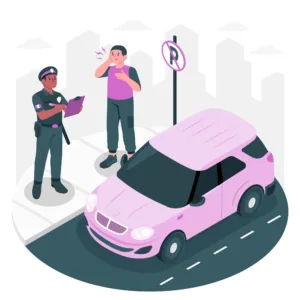Empowering Road Safety: Navigating the Positive Changes of the Motor Vehicle Act 2019

motor vehicle act 2019
Introduction of Motor Vehicle Act 2019:
The Motor Vehicle Act 2019 is a revolutionary force in the ever-evolving field of road safety and transportation, bringing about a paradigm shift in our understanding of and approach to governing our travels on public roads. Highways are the lifeblood of contemporary society, and as such, they require a strong legal system to protect everyone who uses them. The Motor Vehicle Act 2019 is a comprehensive package of reforms that prioritize safety, efficiency, and responsible behavior. It was enacted with the intention of addressing current difficulties.
This ground-breaking law breaks with the established quo by emphasizing the need for proactive measures to reduce traffic accidents, encourage safe driving, and improve traffic management. It represents a dedication to promoting a culture of road safety that goes beyond sanctions, to enlighten, educate, and instilling a sense of shared accountability in all road users.
This essay aims to highlight the positive characteristics that characterize the essence of the Motor Vehicle Act 2019 as we explore it. This legislation is a monument to the proactive actions made by authorities to establish safer roads and foster a sense of shared responsibility among citizens, from increasing fines as deterrents to integrating technology for better enforcement.
Through this comprehensive analysis, we aim to unravel the layers of the Motor Vehicle Act 2019, showcasing its positive impact on road safety, driving norms, and the overall transportation ecosystem. Join us on this journey as we navigate the lanes of change and discover how this legislation shapes a brighter, safer future for all road users.
Key Changes and Amendments:
A variety of noteworthy modifications and adjustments are brought about by the Motor Vehicle Act 2019, all of which are intended to improve road safety, simplify traffic laws, and encourage responsible driving. Let’s examine a few of the most significant changes and the relevant Act sections:
- Increased Penalties (Section 210):
- One of the most notable changes is the substantial increase in fines for various traffic offenses. Section 210 outlines the revised penalty structure, emphasizing a deterrent approach to curb violations and promote adherence to traffic rules.
- New Traffic Offenses (Section 184):
- Section 184 of the Act introduces new traffic offenses, expanding the scope of regulatory measures. This includes stringent penalties for offenses such as overspeeding, dangerous driving, and driving under the influence, underscoring a zero-tolerance approach toward reckless behavior on the road.
- Stricter Drunk Driving Penalties (Section 185):
- The Act significantly revises penalties for driving under the influence of alcohol or drugs. Section 185 outlines the increased fines and potential imprisonment for those found guilty of violating the prescribed limits, reinforcing the gravity of this offense.
- Enhanced Penalties for Juveniles (Section 199):
- Recognizing the need for specialized attention to underage offenders, Section 199 prescribes increased penalties for juveniles involved in traffic violations. This aims to instill a sense of responsibility from a young age and promote safer driving habits.
- Compulsory Vehicle Recall (Section 110A):
- Section 110A empowers the government to mandate vehicle recalls in cases of manufacturing defects or non-compliance with safety standards. This proactive measure ensures that unsafe vehicles are promptly identified and rectified, contributing to overall road safety.
- National Road Safety Board (Section 215A):
- The introduction of Section 215A establishes the National Road Safety Board, emphasizing a strategic and coordinated approach to road safety at the national level. This board plays a crucial role in formulating policies, strategies, and programs to address road safety challenges.
- Electronic Monitoring and Enforcement (Section 134A):
- Section 134A introduces provisions for electronic monitoring and enforcement of traffic rules. This includes the use of technology such as cameras and sensors to detect and penalize traffic violations, ensuring a more efficient and objective enforcement mechanism.
- Aadhaar-based Identification (Section 5A):
- Section 5A allows for the use of Aadhaar for online verification of identity during the issuance of driving licenses and registration certificates. This digital authentication enhances the accuracy and reliability of the licensing process.
The Motor Vehicle Act 2019 has undergone significant modifications and revisions that represent a thorough attempt to solve the issues brought on by changing transportation dynamics. It is clear when we read through the individual sections that the legislative framework aims to create a culture of safe and responsible driving habits in addition to being penalized.

Impact on Road Safety by Motor Vehicle Act 2019:
To make driving safer and more responsible for all users of the road, the Motor Vehicle Act 2019 has had a significant impact on road safety. The Act’s numerous modifications have an impact on several different facets of road safety, including:
- Deterrence through Increased Penalties:
- The substantial increase in fines for traffic offenses, as outlined in the Act, serves as a powerful deterrent. The heightened penalties act as a strong motivator for drivers to adhere to traffic rules, reducing the prevalence of dangerous driving behaviors and, consequently, contributing to a decrease in road accidents.
- Focus on Responsible Driving Behavior:
- By introducing new traffic offenses and stricter penalties for violations, the Motor Vehicle Act 2019 places a significant emphasis on responsible driving behavior. The Act aims to instill a sense of accountability among drivers, fostering a culture of compliance with traffic regulations and promoting safer road practices.
- Curbing Drunk Driving:
- The Act’s revision of penalties for driving under the influence underscores the seriousness of this offense. The stricter measures act as a deterrent, discouraging individuals from engaging in drunk driving and, in turn, reducing the incidence of alcohol-related accidents.
- Enhanced Oversight and Compliance:
- The Act’s provisions for electronic monitoring and enforcement, including the use of technology for traffic surveillance, contribute to improved oversight. This not only facilitates more efficient enforcement of traffic rules but also encourages a culture of compliance among road users who are aware of the increased surveillance.
- Promotion of Road Safety Education:
- The Motor Vehicle Act 2019 recognizes the importance of education in creating a safer road environment. By increasing penalties for juvenile offenders and incorporating educational components into the response to traffic violations, the Act takes a proactive approach to instill road safety awareness from an early age.
- Efficient Handling of Vehicle Recalls:
- The introduction of compulsory vehicle recalls ensures that defective vehicles are promptly identified and rectified. This proactive measure contributes to road safety by addressing potential hazards associated with faulty manufacturing, thereby reducing the risk of accidents caused by vehicle malfunctions.
- National Road Safety Board’s Strategic Role:
- The establishment of the National Road Safety Board underlines the commitment to a strategic and comprehensive approach to road safety at the national level. The board’s role in formulating policies and strategies contributes to a coordinated effort to address systemic challenges and promote a safer transportation ecosystem.
The Motor Vehicle Act 2019 encompasses more than only punitive measures when we evaluate its effect on road safety. It takes a comprehensive approach, tackling systemic issues, behavioral factors, and technology developments to establish a road safety culture that goes beyond law enforcement. The Act aims to increase road safety by highlighting the shared accountability of all parties involved in creating a safe and sustainable transportation environment.
Penalties and Fines:
In an effort to discourage infractions and improve road safety, the Motor Vehicle Act 2019 introduces a thorough revision of the penalties and fines connected with numerous traffic offenses. The following examines the principal fines and penalties and the relevant Act sections:
- General Penalties (Section 210):
- Section 210 outlines the revised penalties for a wide range of traffic offenses. From overspeeding to not wearing a helmet, this section provides a detailed schedule of fines, emphasizing the need for compliance with traffic rules.
- Overspeeding (Section 183):
- Section 183 specifically addresses the offense of overspeeding. Violators face increased fines, reflecting the severity of this common traffic violation that poses a significant risk to road safety.
- Dangerous Driving (Section 184):
- Section 184 prescribes enhanced penalties for dangerous driving, including aggressive and reckless behavior on the road. The increased fines underscore the commitment to curbing behaviors that can lead to accidents.
- Driving Under the Influence (Section 185):
- This section focuses on the serious offense of driving under the influence of alcohol or drugs. The Motor Vehicle Act 2019 significantly raises fines and penalties for individuals found guilty of this dangerous behavior, highlighting a zero-tolerance approach.
- Not Wearing Seat Belts (Section 194B):
- Section 194B addresses the crucial issue of seat belt non-compliance. The Act increases fines for not wearing seat belts, promoting a safer driving environment and reducing the risk of injuries in the event of accidents.
- Not Wearing Helmets (Section 194C):
- Motorcyclists failing to wear helmets face escalated fines under Section 194C. This provision underscores the importance of protective gear and prioritizes the safety of two-wheeler riders on the road.
- Using Mobile Phones While Driving (Section 184B):
- Section 184B targets the hazardous practice of using mobile phones while driving. The Act significantly increases fines for this offense, recognizing the potential distraction and danger it poses to road safety.
- Juvenile Offenses (Section 199):
- Section 199 introduces higher penalties for traffic offenses committed by juveniles. This serves as a measure to instill responsible driving habits from a young age and emphasizes the need for education and awareness.
- Compulsory Vehicle Recall (Section 110A):
- Section 110A empowers authorities to recall vehicles with manufacturing defects or those not complying with safety standards. Failure to comply with a recall notice can result in fines, ensuring timely rectification of safety-related issues.
- Offenses by Enforcement Authorities (Section 210A):
- Section 210A addresses penalties for enforcement authorities who fail to comply with the prescribed procedures. This provision ensures accountability and transparency in the enforcement process.
The Motor Vehicle Act of 2019 includes updated penalties and fines that are outlined in several sections. These changes represent a concerted effort to encourage safe driving practices and improve road conditions. In addition to acting as a deterrent, the higher fines emphasize how crucial it is to follow traffic laws for the safety of all users of the road.
Driving License Reforms:
Major changes to driving licenses are brought about by the Motor Vehicle Act 2019, which emphasizes the need to make sure that drivers have the required training and credentials. The following are the main changes to driving licenses and the relevant Act sections:
- Online Application and Renewal (Section 23):
- Section 23 of the Act empowers authorities to enable online applications for driving licenses, streamlining the application and renewal process. This reform leverages technology to make the licensing process more accessible and efficient.
- Aadhaar-based Authentication (Section 5A):
- Section 5A allows for the use of Aadhaar for online verification of identity during the issuance of driving licenses. This digital authentication enhances the accuracy and reliability of the licensing process.
- Deferred Issuance for Learner’s License (Section 9):
- Section 9 introduces reforms in the issuance of learner’s licenses, allowing authorities to defer the issuance until the applicant demonstrates satisfactory knowledge of traffic rules and regulations.
- Automated Testing Tracks (Section 8):
- Section 8 of the Act emphasizes the establishment of automated driving test tracks. This reform aims to standardize the testing process, ensuring that applicants are evaluated consistently on their driving skills.
- Introduction of Driver Training Schools (Section 15):
- Section 15 allows for the establishment of driver training schools. These schools play a crucial role in providing standardized and structured training programs, contributing to the overall improvement of driving skills among applicants.
- Recognition of Educational Qualifications (Section 8A):
- Section 8A introduces the consideration of educational qualifications in the issuance of driving licenses. This reform recognizes the importance of educational background in determining a driver’s eligibility and responsibility on the road.
- Probationary Licenses for New Drivers (Section 9A):
- The Act introduces the concept of probationary licenses for new drivers under Section 9A. This provision allows authorities to closely monitor and assess the driving behavior of newly licensed individuals during a probationary period.
- Compulsory Refresher Courses (Section 8B):
- Section 8B empowers authorities to make it mandatory for drivers to undergo refresher courses at specified intervals. This reform ensures that drivers stay updated on traffic rules and safety practices throughout their driving tenure.
- National Register for Driving Licenses (Section 26A):
- Section 26A mandates the establishment of a National Register for Driving Licenses, centralizing information to enhance the efficiency and reliability of the licensing system.
- Recognition of International Driving Permits (Section9B):
- Section 9B allows for the recognition of international driving permits, facilitating the ease of travel for individuals holding valid licenses from other countries.
All together, these driving license reforms—which are included in different parts of the Motor Vehicle Act 2019—seek to strengthen the integrity of the licensing system, raise driving standards, and guarantee that anyone operating a motor vehicle have the required training and expertise.
Public Awareness and Education:
A heavy emphasis on public awareness and education is placed by the Motor Vehicle Act 2019 in recognition of the critical role that education plays in promoting a culture of road safety and responsible driving behavior. The Act has a number of provisions intended to enlighten, instruct, and involve the public in comprehending and abiding by traffic laws. The following are important public awareness and education-related factors and their respective Act sections:
- Educational Components for Traffic Violations (Section 206B):
- Section 206B introduces the concept of educational components as part of the response to certain traffic violations. Offenders may be required to undergo educational programs to enhance their understanding of road safety norms and foster responsible behavior.
- National Road Safety Board’s Educational Initiatives (Section 215A):
- Section 215A establishes the National Road Safety Board, which plays a crucial role in formulating policies and strategies for road safety. This includes educational initiatives aimed at creating awareness and educating the public about the importance of adhering to traffic rules.
- Road Safety Awareness Campaigns (Section 129):
- Section 129 empowers the central government to promote road safety awareness through campaigns and programs. These initiatives are geared towards educating the public about safe driving practices, the importance of wearing seat belts and helmets, and other critical aspects of road safety.
- Community Participation in Road Safety (Section 129A):
- Section 129A encourages community participation in road safety measures. This provision aims to involve local communities in creating awareness, organizing events, and actively contributing to road safety education at the grassroots level.
- School and College Programs (Section 129B):
- Section 129B emphasizes the integration of road safety education into school and college curricula. By incorporating educational programs at an early age, the Act seeks to instill a sense of responsibility and awareness among future drivers.
- Publications and Materials for Awareness (Section 129C):
- Section 129C enables the central government to publish and distribute materials related to road safety. This may include brochures, pamphlets, and digital content aimed at educating the public on various aspects of safe driving and traffic regulations.
- Online Learning Platforms (Section 28A):
- The Act introduces Section 28A, which allows for the use of online platforms for imparting driver training and education. This provision embraces technology to make educational resources more accessible to a wider audience.
- Public Service Announcements (Section 74A):
- Section 74A empowers authorities to use public service announcements for disseminating information related to traffic rules and road safety. These announcements serve as a powerful tool for reaching a broad audience and reinforcing key messages.
The Motor Vehicle Act 2019 emphasizes the value of awareness and education as essential elements of road safety by introducing these clauses. The Act acknowledges that knowledgeable and aware drivers are more likely to follow traffic laws, make roads safer, and actively participate in fostering a culture of responsibility on the roads.
State-wise Implementation:
The Motor Vehicle Act of 2019 is being implemented at the state and union territory level in India, as of January 2022, the last time I checked. States may adopt, amend, or put into effect the Act’s provisions in accordance with their own requirements and preferences. The Act offers a framework, and states are free to customize its use in accordance with regional needs and goals.
Here’s a broad overview of possible state approaches to the Motor Vehicle Act 2019 implementation:
- Adoption and Modification:
- States may choose to adopt the Motor Vehicle Act 2019 in its entirety or make modifications to certain provisions based on their unique circumstances. This flexibility allows states to address local challenges and concerns.
- Timeline for Implementation:
- The timeline for implementing the Act’s provisions may vary from state to state. Some states might choose to implement the changes promptly, while others may take a phased approach to allow for a smoother transition.
- Communication and Public Awareness:
- States are likely to conduct public awareness campaigns to educate citizens about the changes introduced by the Motor Vehicle Act 2019. This could include disseminating information through official websites, media channels, and other communication platforms.
- Infrastructure and Technology Readiness:
- Implementation may also depend on the state’s readiness in terms of infrastructure and technology. States may need time to set up the necessary systems for electronic monitoring, online licensing, and other technological aspects introduced by the Act.
- Training for Enforcement Personnel:
- Law enforcement agencies in each state will need to be trained on the updated provisions and procedures outlined in the Motor Vehicle Act 2019. Training programs may be conducted to ensure effective and uniform enforcement.
- Consideration of Regional Factors:
- States may take regional factors into account when implementing the Act. For example, states with distinct traffic patterns, climatic conditions, or urban-rural dynamics may tailor certain provisions to better suit their local context.
- Public Feedback and Consultation:
- States might seek public feedback and engage in consultations with stakeholders before finalizing the implementation strategy. This could involve discussions with transport associations, citizens, and other relevant groups.
- Monitoring and Evaluation:
- States are likely to monitor the impact of the implemented changes regularly. This may involve assessing changes in road safety, compliance levels, and any challenges or concerns raised by the public.
It’s important to remember that state-by-state implementation details can change, and the data presented here is only an outline. It is advised to check with the official transportation for the most accurate and current information.
Conclusion:
To sum up, the Motor Vehicle Act 2019 is a groundbreaking piece of legislation that has the power to drastically alter India’s transportation and road safety landscape. The Act, with its all-encompassing provisions and progressive improvements, demonstrates a dedication to promoting responsible driving, safer roads, and a more efficient traffic management system.
The Act’s severe penalties for moving violations, which are designed to serve as a strong deterrent and foster a sense of accountability among road users, are a clear indication of its impact on road safety. The higher fines highlight a zero-tolerance policy toward actions that endanger public safety, especially for speeding, reckless driving, and driving while intoxicated.
The Act’s modifications to driving licenses lead to a more exacting and uniform licensing procedure. The focus on Aadhaar-based verification, automated testing tracks, and online applications shows a dedication to using technology to create a licensing system that is more transparent and effective.
The Act’s emphasis on education and public awareness is a positive step in creating a responsible driving culture. Road safety education is included into school curricula, driver training schools are established, and educational components for specific traffic violations all help to create knowledgeable and responsible drivers.
The Motor Vehicle Act 2019’s state-by-state implementation, however, introduces a level of complexity by enabling each state to customize the adoption and amendment of sections by their particular needs. This flexibility takes into account the various geographical characteristics and difficulties that affect how well the Act is implemented.
The Act’s effects on traffic control, road safety, and overall transportation efficiency must be continuously monitored as it is implemented throughout the nation. To guarantee that the Act succeeds in building a more secure and sustainable transportation ecosystem, it will be crucial to implement regular assessments, public feedback channels, and modifications to meet new issues.
In essence, the Motor Vehicle Act 2019 represents a forward-looking and comprehensive approach to addressing the complexities of India’s roadways. It is a testament to the collective effort to prioritize safety, responsibility, and efficiency in the journey toward a better-connected and safer nation.




1 thought on “Empowering Road Safety: Navigating the Positive Changes of the Motor Vehicle Act 2019”